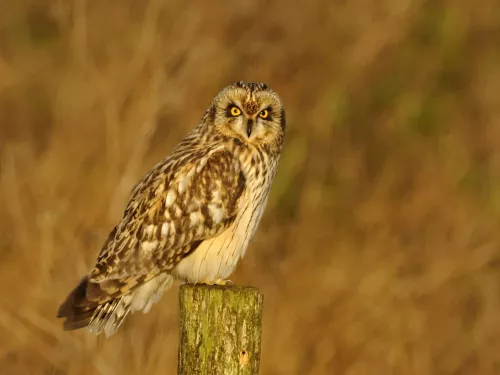
Short-eared owl
The short-eared owl, or 'Shortie', is an unusual owl because it prefers to be out and about in the daytime. Learn more about it in our species information page.

The short-eared owl, or 'Shortie', is an unusual owl because it prefers to be out and about in the daytime. Learn more about it in our species information page.
One of 2 seahorses found in UK seas, short snouted seahorses are recognisable by their shorter snout - surprisingly enough!
Living up to its name, the shoveler has a large and distinctive shovel-like bill which it uses to feed at the surface of the water. It breeds in small numbers in the UK, but is widespread in winter.
The shrill carder bee can be spotted flying quickly around flowers in unimproved pastures. The queens produce a loud, high-pitched buzz, hence the name. It is declining rapidly and is restricted to just a few locations.
A spindly tree of heathland and moorlands, and dry and sandy soils, the Silver birch is well known for its paper-thin, white bark. It is a great coloniser and can quickly spread in an area.
The Silver Y migrates to the UK in massive numbers each year - sometimes, an estimated 220 million can reach our shores in spring! Seen throughout the year, it is very common in gardens and grasslands.
The dazzling silver-studded blue is a rare butterfly of heathland habitats, mainly in southern England. It has undergone severe population declines in recent years.
The silver-washed fritillary gets its name from the silver streaks on its underside. It is on the wing in summer, preferring sunny glades in woodlands. Despite declines, its range has spread over recent years.
The silverfish is so-named for its fish-like way of moving and its silvery scales. It can be found in the damp corners of the house, such as the kitchen or bathroom. Infestations can cause serious damage.
As its name suggests, Silverweed has silvery leaves with toothed edges. It can be found in grassy places, along roadsides and on waste ground - look for yellow, saucer-shaped flowers and red runners.
An attractive, green-and-yellow bird, the siskin regularly visits birdtables and feeders in gardens. Look for the bright yellow barring on its black wings, and the black crown of the males.
The Sitka spruce was introduced into the UK from North America in the 19th century. It has been widely planted as a forestry tree; look for classic needle-like leaves and pale brown, domed cones.